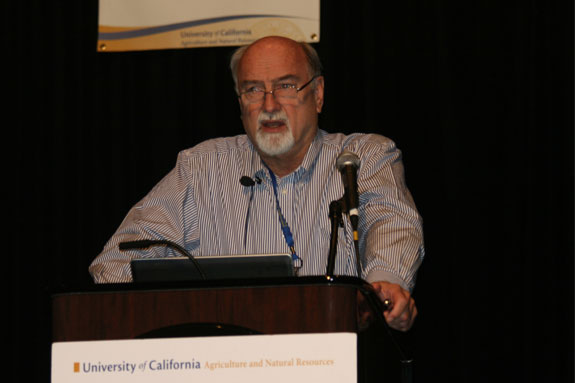What are the three biggest issues facing alfalfa production? Water, water and water. Certainly no one at the 2013 Western Alfalfa & Forage Symposium held in Reno, Nevada, in December had a crystal ball to forecast hay production and prices, but most seemed to agree on one thing – water will write the hay story.
Seth Hoyt, author of the widely circulated ‘The Hoyt Report,’ told nearly 600 symposium attendees that while drought conditions worsened in parts of the West, constant rains plagued growers in Washington and damaged large amounts of hay in Idaho, Utah and some areas of Nevada, reducing overall quality. 
Yet, that being said, irrigation water supplies were also threatened and are of continuing concern going into 2014, requiring above-normal snow packs to restore irrigation water to normal levels.
Hoyt expects to see an overall increase in alfalfa acres in Western states in 2014 due, at least in part, to the drop in grain prices.
Water availability in the Mideast has affected the export market, as well, according to Bill Matthews, researcher with the University of California – Davis, and has played a factor in transitioning hay exports “from a footnote to a major factor for western hay markets.”
In his presentation, Dr. Matthews noted the United Arab Emirates decided in 2008 to stop producing alfalfa hay due to the increasingly scarce water resources.
Pumped water largely originates from nonrenewable fossil sources, yet the herds in the region still require forages, ergo the demand for U.S. hay exports. Matthews cites sources expecting a similar decision from the government of Saudi Arabia in the near future.
In response to water issues and in an effort to better utilize marginal water sources and soils with higher saline content, alfalfa seed companies are working to develop salt tolerant varieties.
Donald Miller, product development director at Producers Choice, says, “Directly related to the dwindling water supply for irrigation is a growing problem of soil salinity. "… In irrigated forage production regions, the salinity problem is increasing as farmers move from flood irrigation to sprinkler irrigation as a means of conserving water and improving irrigation efficiency.
Sprinkler irrigation systems apply significantly less water, and as a result salts stay near the soil surface as compared to flood irrigation, which tends to leach the salts down below the root zone.”
According to Ian Ray, professor of alfalfa breeding and genetics at New Mexico State University, researchers are also investigating DNA markers to develop alfalfa varieties for a water-challenged future.
Ironically, getting water into the hay is only half the story – the other half is determining best management practices to get the moisture out of the hay for storage.
A number of presenters tackled this issue by discussing methods to prevent hay fires (Glenn Shewmaker, University of Idaho), harvest drying strategies (Dan Undersander, University of Wisconsin), and silage management (Steve Fransen, University of Washington).
In addition to more than 30 presentations by university and industry personnel, the symposium offered a trade show of 70 exhibitors, an auction to benefit the California Alfalfa and Forage Association, and a discussion by Bill Frost, cooperative extension director with University of California – Agriculture and Natural Resources, regarding the future of cooperative extension and why western forage growers need to care.
Noting cooperative extension’s success and vitality in pest management, seed variety development and testing, and water use efficiency and management work, Frost also noted, “Cooperative extension personnel are usually heavily engaged when new regulatory approaches are proposed and provide science-based information pointing out the validity or lack of validity in the proposed rule.”
Taking California as an example in regards to number of extension personnel, Frost said, “If you look at our overall numbers compared to 1990, we’re at 50 percent of where we were then.”
Frost cited reductions in federal and state funding as causes, with no foreseen significant increases pending. To rectify the personnel deficits, Frost recounted industry collaborations with, for instance, California Rice Research Board, California Table Grapes Commission, and California Pistachio Research Board, which have all stepped forward to fund extension positions as specialists and county-based advisors.
“While political support remains critical, private partnerships are the wave of the future,” Frost said, and are needed to leverage federal and state funding deficits. He says it’s time for industries to consider partnerships to assist in funding positions that support their industries. FG
PHOTOS
TOP AND MIDDLE: Trade show exhibits presented equipment and forage trends to nearly 600 people at the 2013 Western Alfalfa and Forages Symposium recently held in Reno, Nevada.
BOTTOM: University of Wisconsin Forage Extension Coordinator Dan Undersander leads one of 30 symposium presentations to keep producers abreast of forage trends and best management practices. Photos by Lynn Jaynes.












